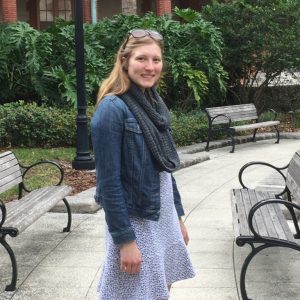By: Publicity Intern Nicole Towne
 On a fall afternoon in September, I leave my spot at the computers in the first floor office and walk up the stairs to the third floor to meet with music Professor John Pierce. We plan to discuss the upcoming opera he is directing. We sit in the organized office with a glossy black piano as he tells me how he came into opera. It seems that it was almost by chance. A professor of his asked him if he would be interested in being in an opera. To that, Pierce responded, “What is an opera?” I laugh not only from the bluntness of the statement, but also because that humble moment in time was the springboard for Pierce’s international career. He tells me how the opera vocalists project their voices without a microphone and often over the music pouring out of an orchestra pit. I am a novice to the opera scene, Pierce speaks in a way a non-music major can understand. Midway through the interview, a music student starts warming up in the hallway. Then he plays the “Star Wars” theme song on a horn instrument I cannot identify, but I can appreciate
On a fall afternoon in September, I leave my spot at the computers in the first floor office and walk up the stairs to the third floor to meet with music Professor John Pierce. We plan to discuss the upcoming opera he is directing. We sit in the organized office with a glossy black piano as he tells me how he came into opera. It seems that it was almost by chance. A professor of his asked him if he would be interested in being in an opera. To that, Pierce responded, “What is an opera?” I laugh not only from the bluntness of the statement, but also because that humble moment in time was the springboard for Pierce’s international career. He tells me how the opera vocalists project their voices without a microphone and often over the music pouring out of an orchestra pit. I am a novice to the opera scene, Pierce speaks in a way a non-music major can understand. Midway through the interview, a music student starts warming up in the hallway. Then he plays the “Star Wars” theme song on a horn instrument I cannot identify, but I can appreciate
When I think about my time working at the UCA this past semester, I often think of this experience. The UCA is full of history, creativity, talent, and surprise. The building itself is a renovated version of Fort Collins’ first high school, built in 1924 and used through 1995. The main entrance is guarded by eight tall pillars of prestige. When I walk down these halls, sometimes I like to think about the people who have been here before me. Did young ladies walk to class in tea length skirts with books and notebooks in their arms? Did students pass hand written notes in class? Now, I watch as students carry instruments twice their size down the hall.
What goes on beyond these front doors matter. Ideas are born here. Musicians come together in syncopation. Dancers take a sequence and form a performance. Actors and actresses take words on a piece of paper and bring a persona to life. Technical theatre students take pieces of wood and buckets of paint and make a set.
If you stick around the UCA long enough, you will see art come to life. As an intern writing about events in music, theatre, and dance, I have had the privilege to see productions come together. I have sat in on a rehearsal for dance Professor Matthew Harvey’s fall dance concert piece. I have watched actors and actresses in Love and Information practice lines within the taped outline of a stage on the floor of the second floor acting studio. One of the best parts of it all is when I can sit in the audience and see the final product and recognize sequences or students I interviewed with.
In a time defined by screens, the arts continue to prevail. The best way you can support it is by continuing to show up and watch as students move, speak, sing, dance, and play in real time.
During my interview with Professor Pierce, he left me with a piece of knowledge that I continue to take with me whenever I experience the arts. Whatever live show you are watching whether it is music, theatre, or dance is a unique experience that should be honored.
“This is a once in a life time experience,” Pierce said. “There will never be this performance again. Every performance is slightly different. The one you are sitting and watching will never be repeated.”

